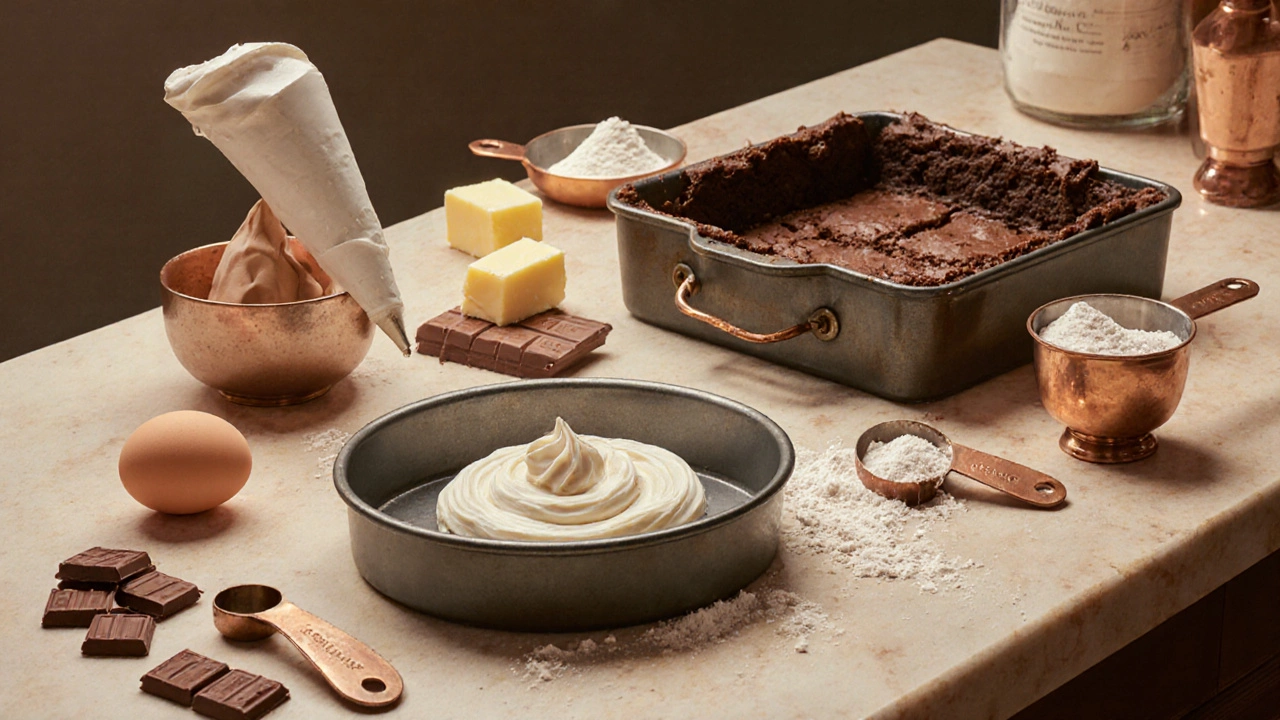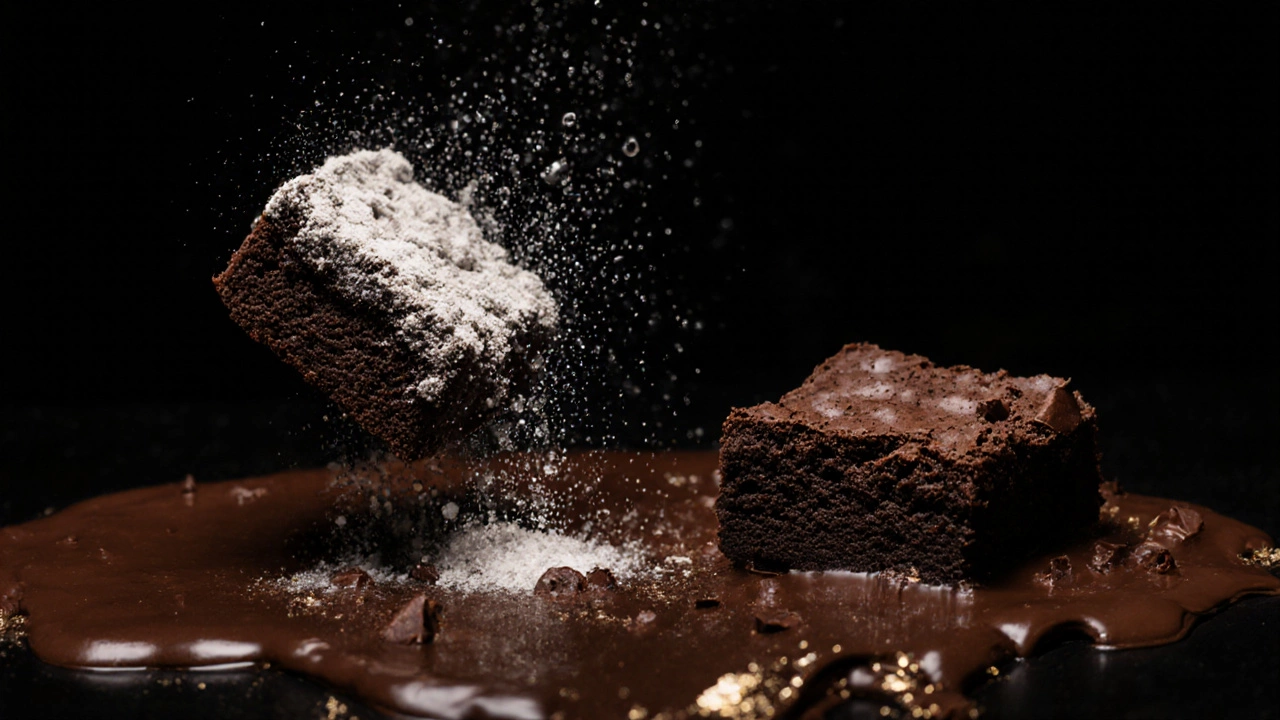
Cake vs Brownie Calculator
Determine Your Dessert's Texture
Results
Ever stared at a slice of brownie and a slice of cake side by side and wondered why they feel so different-even when they’re both chocolatey and sweet? You’re not alone. Many people think brownies are just dense cake, but that’s not quite right. They share ingredients, they share an oven, and sometimes they even share a plate. But under the surface, they’re built differently. And knowing how matters-whether you’re baking for a crowd, trying to fix a failed batch, or just curious why your brownie doesn’t melt the way your cake does.
Texture Is Everything
The biggest difference between a cake and a brownie? Texture. A cake is light, airy, and soft. It springs back when you press it. That’s because cakes rely on chemical leaveners like baking powder or baking soda to create air pockets. When you mix the batter, you’re building structure around bubbles that expand in the heat. The result? A fluffy crumb that holds its shape but gives way easily.
Brownies? They’re the opposite. A good brownie is dense, fudgy, or chewy-never fluffy. You don’t want air in there. You want richness. That’s why most brownie recipes skip baking powder entirely. Instead, they use melted chocolate and butter to create a thick, heavy batter. The structure comes from eggs and sugar, not from rising agents. When you bake it, the edges crisp up while the center stays molten. That’s not a mistake-that’s the goal.
Ingredients Don’t Lie
Look at the ingredient lists, and you’ll see the pattern. A typical cake recipe has more flour, more liquid (milk, buttermilk, or water), and less fat. It balances sweetness with structure. A chocolate cake might use cocoa powder, but it still needs enough flour to hold its shape when sliced.
Brownies? They’re loaded with fat. Butter, chocolate, sometimes even oil. Flour is kept to a minimum-sometimes as little as half a cup for a full pan. Eggs aren’t just for binding; they’re for richness and chew. Sugar isn’t just sweetener-it’s what gives brownies their glossy top and sticky bite. No milk? No problem. Many classic brownie recipes don’t use any liquid besides eggs.
One study from the Institute of Food Technologists found that brownies with less than 15% flour by weight had the highest fudginess rating among testers. Cakes, by contrast, usually contain 25-35% flour. That’s not a small difference-it’s the reason one sinks into your fork and the other lifts away.
How They’re Baked Changes the Outcome
Both bake at around 350°F (175°C), but how long and how you test them? Totally different.
Cakes are done when a toothpick comes out clean. You want the center fully set. Underbake a cake? It collapses. Overbake it? It turns dry and crumbly.
Brownies? You want the toothpick to come out with a few moist crumbs. If it’s clean, you’ve overbaked them. The center should still jiggle slightly when you shake the pan. That’s not underdone-that’s perfectly fudgy. A brownie baked to cake standards will taste like a chocolate brick. No one wants that.
Also, pan size matters. Brownies are baked in square or rectangular pans to maximize edge pieces-the crispy, caramelized corners that everyone fights over. Cakes? Round pans. Layered cakes need even baking from edge to center, so the shape is designed for uniform heat flow. Brownies? They thrive on unevenness.

How They’re Served Tells the Story
Cakes are often layered, frosted, and decorated. They’re celebration food-birthdays, weddings, anniversaries. They’re meant to be cut into neat slices and served with forks.
Brownies? You tear them. You eat them with your hands. You leave them on the counter for days because they don’t dry out like cake. They’re snack food. Dessert food. Midnight food. They’re often served plain, sometimes with a dusting of powdered sugar or a scoop of ice cream melting on top. No frosting needed. The chocolate is the star.
And here’s a little secret: brownies age better than cakes. After two days, a cake might get stale. A brownie? It gets richer. The flavors meld. The texture softens just enough. That’s why people freeze brownies and pull them out weeks later. Try that with a sponge cake and you’ll get a cardboard square.
When to Choose One Over the Other
If you’re baking for a birthday party with kids? Go with cake. It’s familiar. It’s colorful. You can pipe frosting and add candles.
If you’re hosting a quiet evening with friends and want something indulgent, no-fuss, and deeply satisfying? Brownie. No oven space for a layer cake? Brownie. Need to make a dessert that travels well? Brownie. Want to impress someone without spending hours decorating? Brownie.
And if you’re trying to fix a recipe that came out too dry? Check your flour ratio. Too much flour turns a brownie into a cake. Too little and it falls apart. The sweet spot is usually 1/2 to 3/4 cup flour per 12-ounce package of chocolate.

Common Mistakes People Make
- Using baking powder in brownies thinking it’ll make them fluffier-it won’t. It’ll make them cakey and weird.
- Measuring flour by volume instead of weight. A cup of flour can vary by 20 grams depending on how you scoop it. That’s enough to ruin a brownie.
- Overmixing the batter. Brownies develop gluten when stirred too much, leading to a tough, chewy texture instead of a rich, fudgy one.
- Expecting them to rise. Brownies don’t rise like cakes. If yours puffs up in the oven and then sinks? That’s normal. It’s not broken.
- Storing them in the fridge. Cold temperatures dry out brownies. Keep them at room temperature in an airtight container.
Can You Turn a Brownie Into a Cake?
Technically, yes-but you shouldn’t. If you add more flour, baking powder, milk, and bake until a toothpick comes out clean, you’ll get something that looks like a brownie cake. But it won’t taste like either. It’ll be a compromise: not fluffy enough to be cake, not dense enough to be brownie.
There’s a reason brownie recipes are called brownie recipes, and cake recipes are called cake recipes. They’re two different desserts with two different purposes. One is comfort. The other is celebration.
Respect the difference. Master both. And if you’re ever unsure? Go with the brownie. It’s never wrong.
Can I use cake flour for brownies?
You can, but it’s not ideal. Cake flour has less protein than all-purpose flour, which means less gluten formation. That might sound good, but brownies need just enough structure to hold together without becoming cakey. Using cake flour can make brownies too tender and crumbly. Stick with all-purpose flour unless you’re experimenting.
Why do brownies have a shiny top?
The shiny top comes from sugar dissolving into the batter and then crystallizing on the surface as it bakes. When you beat sugar into melted butter and chocolate, it creates a syrupy layer that rises to the top. That’s why whisking the sugar and eggs together before adding dry ingredients helps-more air and sugar suspension equals a better crust.
Are brownies considered cake?
No, brownies are not cake. While both are baked desserts, brownies are classified as bar cookies or confections because of their dense texture, minimal leavening, and high fat-to-flour ratio. Cake, by definition, relies on leaveners and has a light, porous crumb. Brownies are closer to fudge than to cake.
Why do my brownies turn out cakey?
Cakey brownies usually mean too much flour, too much baking powder, or overmixing. Brownies need minimal flour-usually under 1 cup per 12 oz of chocolate. If you’re using baking powder, stop. And don’t beat the batter after adding flour. Mix just until combined. That’s it.
Can I make a brownie without eggs?
Yes, but it changes the texture. Eggs provide structure and richness. Without them, brownies become more like fudge or dense chocolate bars. Flaxseed meal or mashed banana can replace eggs, but you’ll lose the chew. For best results, use a recipe specifically designed to be egg-free-don’t just substitute.